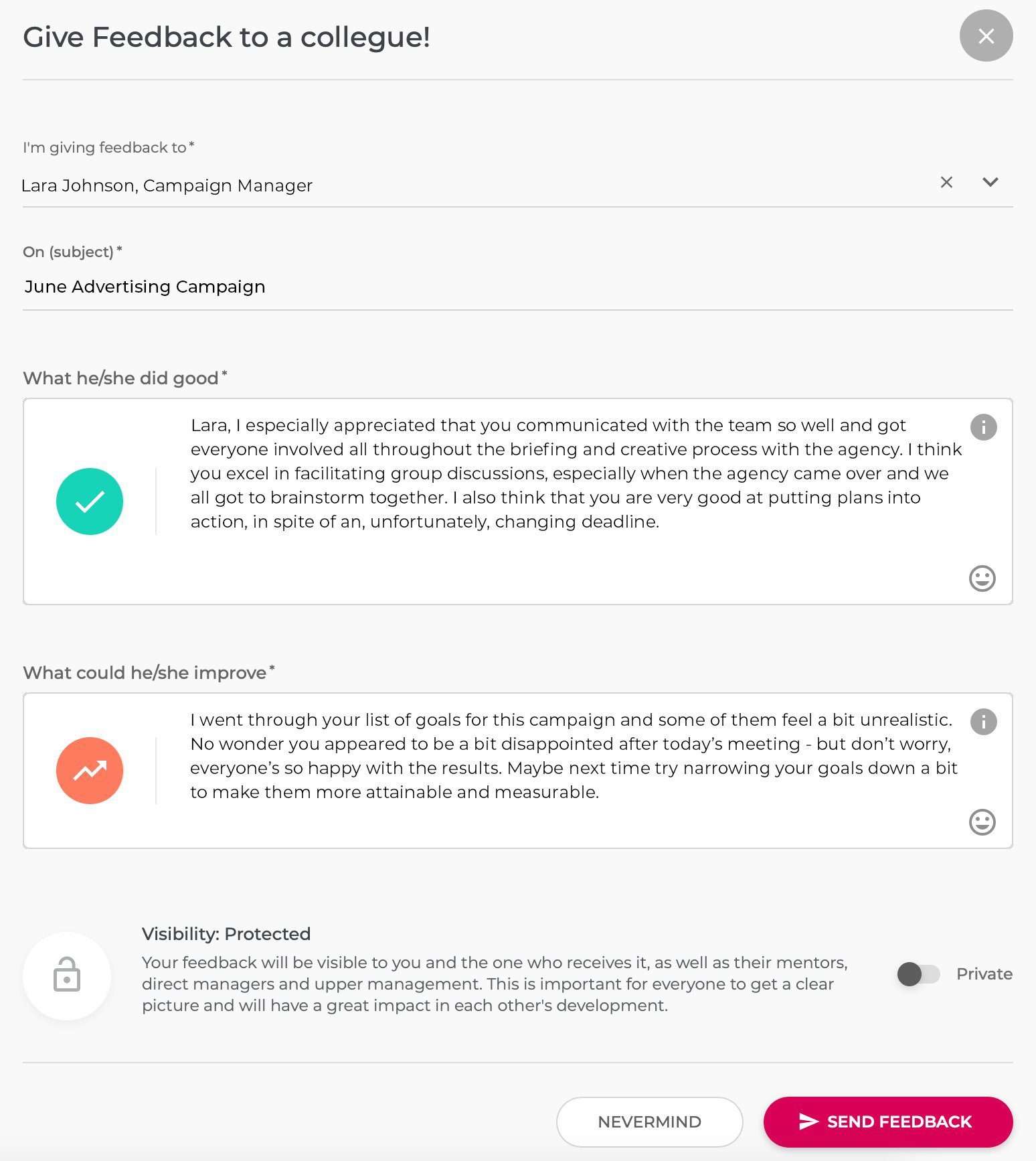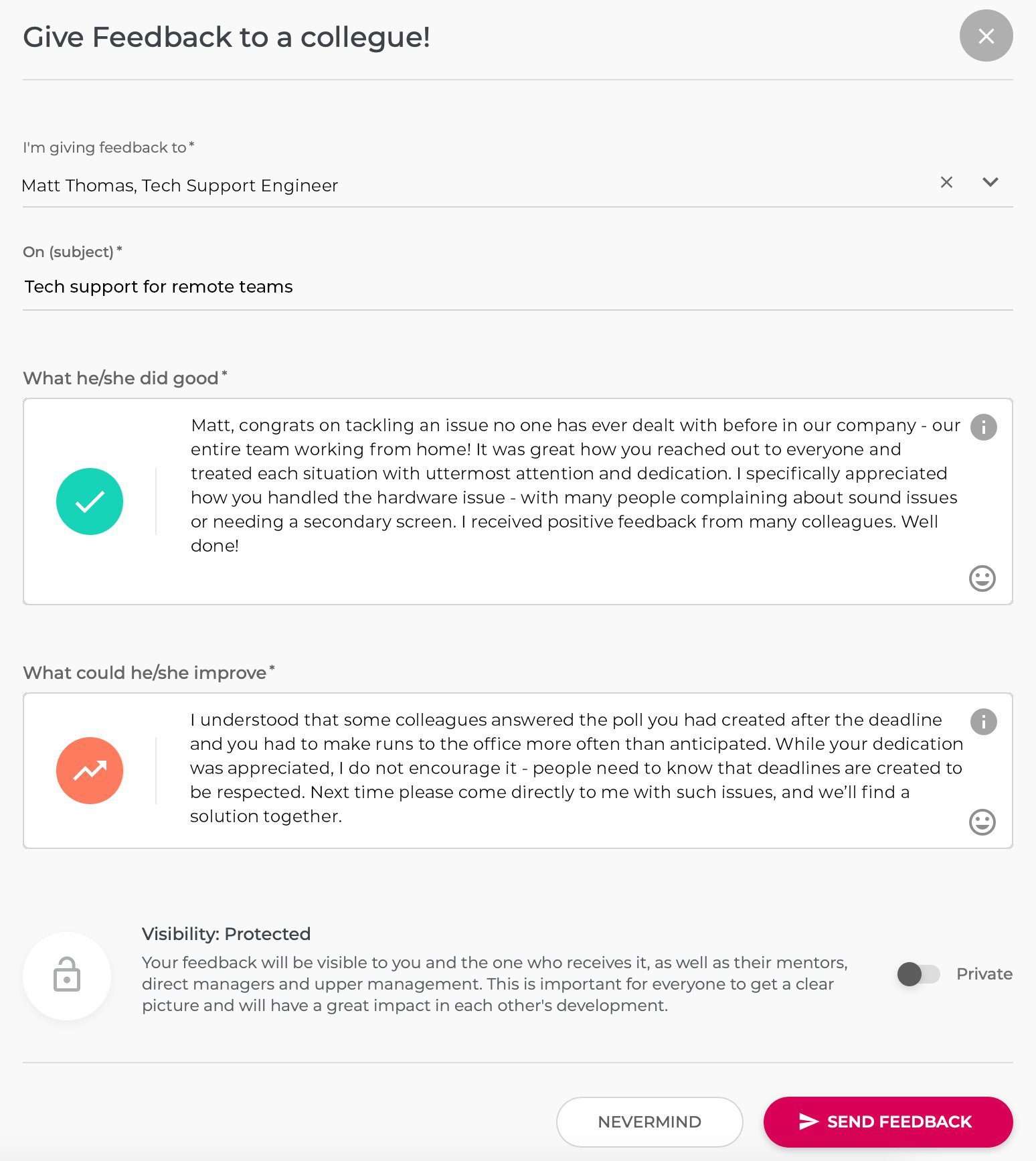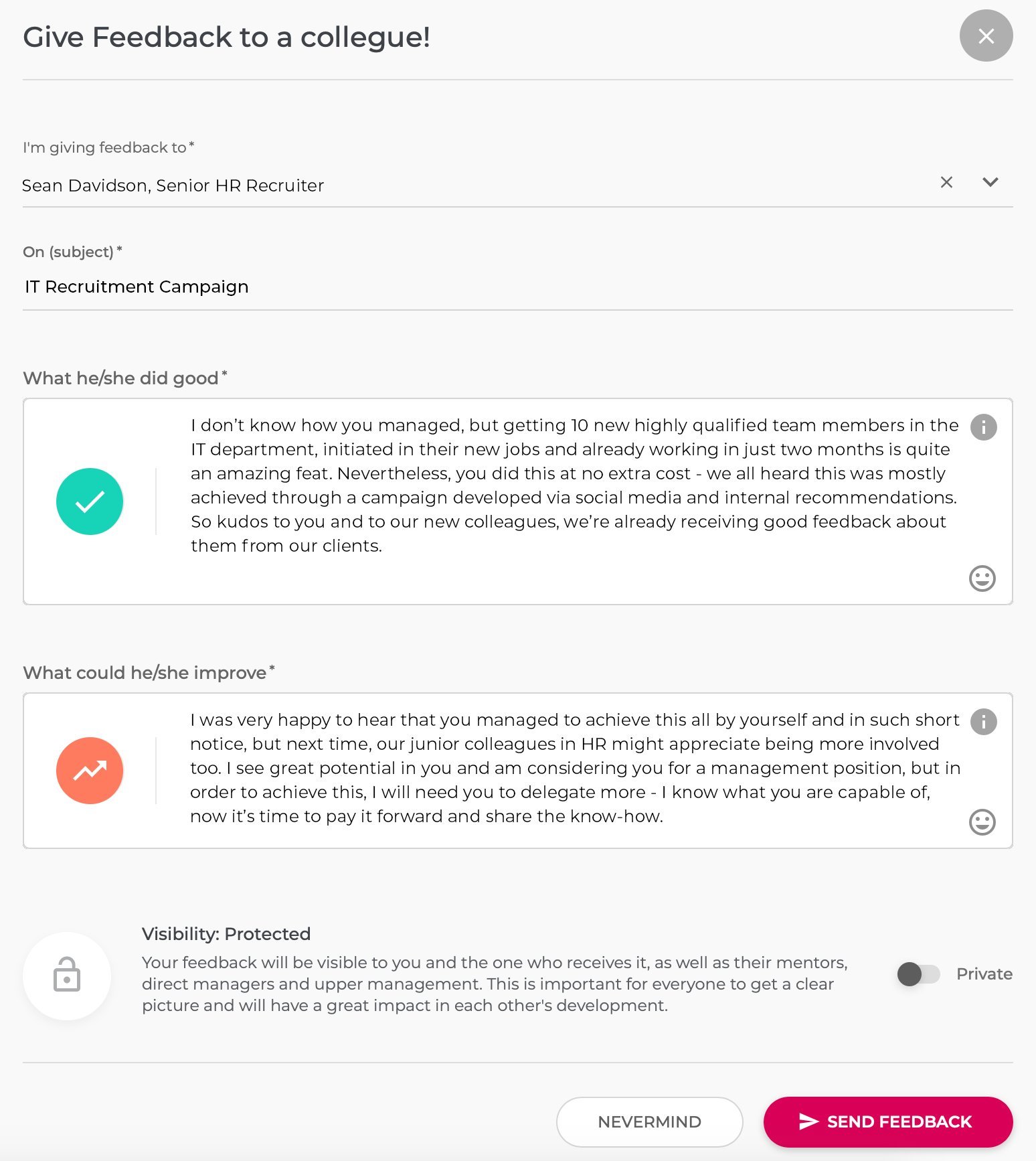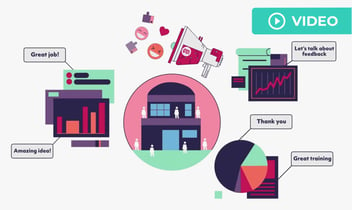Refresh Your Mindset: How to Give Better Feedback, with Examples

Let’s face it. Giving feedback is one of the most difficult aspects of the job, whatever kind of job we’re talking about, even though managers are probably most often faced with it during their everyday activities. However, those in other positions are not exempt from the much-feared feedback, either, whether we “have to” give it or receive it. That is why we believe how to give feedback should attract a lot more attention from managers and non-managers alike, and mind you, here is some food for thought: it should even be a bit more regulated, as some may be a bit too loose with it.
But first things first.
Why you need a culture of feedback in your company
By definition, in an organizational context, feedback is the information sent to an entity, be it an individual or a group, about its prior behavior so that the entity may adjust its current and future behavior to achieve the desired result.
However, stepping aside from an academic framework, feedback is also something that is trending nowadays. Everyone gives it, but too many times, it is unsolicited, and if done without tact, it can even come with unexpected consequences.
How, you may ask?
Just imagine this scenario: Linda, a more experienced software developer refers to the code developed by Sam, the new colleague, as “sloppy”, in a probably playful, “like-you-kids-do-nowadays” manner. However, Sam, who looks up to Linda, is very affected by her comment and, since she is a senior member of the team, he considers her to be the voice of other members of the team.
Sam begins to feel underappreciated, starts underperforming, and maybe even begins looking for another job.
The above example may seem like a mild exaggeration, but the reality is that it is not. We are encouraged to speak our minds ever since kindergarten, however, we should do so considering a few simple aspects: that we should always keep things professional, as the office space does come with a set of dedicated rules, and maintaining a diplomatic approach when dealing with our colleagues should always be one of them. Familiarity is welcome, but perhaps other contexts are better suited for it.
This is where a carefully designed and well-thought culture of feedback steps in. By definition, a culture of feedback equips absolutely anyone and everyone in the organization with the proper tools to give constructive criticism to anyone else in the company. However, the emphasis here should be on “constructive”, because feedback is much more than just an opinion we speak, and that should always be considered beforehand.
Giving feedback is more than being randomly honest, it’s about being considerate too. And that, in the pursuit of appreciation from peers or just for the sake of standing out, is often forgotten.
In the words of our expert, Elena Ungureanu, senior HR specialist at Mirro: “Feedback is about honesty and it is a way to build trust. It’s important to recognize the people you work with, to help them understand both their strengths and contribution to the company, as well as the skills they need to improve. I encourage them to be honest, to give concrete examples, and to deliver it in a candid way. Also I suggest they think about how they would feel if they received that feedback, before giving it.”
So, without further ado, here is...
How to give better feedback in ten easy-to-implement steps
We know, ten steps may sound like quite the effort. However, you may have already implemented many of these and not even known it. All they need now is a more unitary approach so that they can integrate better into the concept of a feedback culture within your company. But let’s start at the beginning:
- Be the first to set an example
True leaders inspire their followers through concrete actions. It’s your job to show that the company and its people are open to constructive feedback - so be the first to set the tone on how this is done. A moderate, diplomatic, and well-balanced leader will inspire the same kind of behavior throughout. However, aggressive and sarcastic comments, served with a superior attitude, may spread faster than wildfire and will surely not serve anyone. So be sure to avoid these and discourage them in others, as well.
- Look for people with a growth mindset
People with a growth mindset are a true gem and can be easily identified right from the earliest stages of recruitment. Such individuals regard feedback as a natural part of their profession, as well as a natural way to constantly improve themselves, which is definitely something you need in your organization.
But solely hiring people focused on growth is not enough. Continuously invest in growth as well, encourage existing team members to constantly take new courses and upgrade their skills, and, why not, even invest in such things as feedback training. This may not even need to be a consistent investment - the colleagues that have aced this skill can simply hold training sessions for others.
- Turn feedback into routine
No need to wait until the quarterly review to give someone feedback. When incorporated into the daily routine, feedback becomes less feared and is accepted as an everyday activity, just like anything else. Let’s not forget that culture represents a set of shared traditions, habits, artifacts, and language. Therefore, it’s in your power to create shared experiences around giving and receiving feedback, all in a positive and respectful manner.
- Ask for feedback too
Sometimes, people regard asking for feedback as a sign of vulnerability. However, demanding input about initiatives that directly concern individuals is only another means of building a strong culture of feedback and trust. It is only a sign of vulnerability if we make it one. In reality, it is a desire to deliver constantly better results.
- Always be specific
Feedback like “Your work needs improvement” can hardly be qualified as such. If you want to give input, make sure to refer to a certain task. Otherwise, a general comment will just leave an individual even more confused than before. On the other hand, a suggestion as “your presentation needed a bit more figures” hits the spot just perfectly and guides the targeted individual towards a desired action.
- Negative feedback is welcome, but never publicly
The same applies to praise, too. It is best to discuss with team members during casual, informal meetings - walks can be a very effective meeting strategy, and talking over coffee can turn out to be quite productive and inspiring, too. Such less formal settings will remove authority barriers and will allow for more open communication - the perfect setting for even more negative feedback.
Here’s another explanation for public appraisal and why you should reconsider it, as illustrated by David Rock in his book “Your Brain at Work: Strategies for Overcoming Distraction, Regaining Focus, and Working Smarter All Day Long”:
“Giving people positive feedback, pointing out what they do well, gives others a sense of increasing status, especially when done publicly. The trouble is, unless you have a strong director, giving other people positive feedback may feel like a threat, because of a sense of a relative change in status. This may explain why, despite employees universally asking for more positive feedback, employers seem to prefer the safer “deficit model” of management, of pointing out people’s faults, problems, and performance gaps, over a strengths-based approach.”
- Pay attention to the questions you’re asking
Although it may come naturally to ask someone why they acted a certain way, a better approach would be to formulate more thought-provoking questions, such as: “What would you do differently to avoid this situation in the future, and improve your results?”. This technique allows the individual to better understand the situation and helps them feel more involved, rather than punished for their actions.
- Consider performance, not personality
There’s a very thin line between taking feedback personally and professionally. Whether we decide to focus on the first or the latter makes it easier or more difficult for someone to take criticism. Example:
“It would be more efficient if we made casual conversation with the clients at the end of the meeting, to make sure we don’t run out of time for our eCommerce presentation.” (performance)
...instead of:
“Your superficial nature almost cost us a few important slides from the eCommerce presentation” (personality)
- Make sure to end on a positive note
Let’s not forget: as we mentioned throughout this article, the goal of constructive feedback is to help someone improve. The best way to achieve this is by ending your input, verbal or written, in an optimistic manner, rather than by continuing to highlight what was done wrong. After all, feedback is just a conversation, and there should be no reason for it to be feared in the future.
- Empower your teams with the right feedback tools
If a bit earlier on in the article I asked for input from Elena Ungureanu, senior HR specialist at Mirro, it’s time for me to pass the mic to another Mirro expert, Bogdan Ionita, product manager, as this last point was written directly from his very own experience of working with CEOs, entrepreneurs, and HR experts from various backgrounds and cultures.
“Face-to-face feedback is a bliss for companies. Great team mates interact constantly, on the spot, and feel safe to share their feedback related to a certain, specific context. This creates camaraderie, which ultimately leads to better results.”
However, trying to count the number of companies for which this is a reality will take your efforts on a wild goose chase, continues Bogdan.
But why is it so? “It’s a matter of habit, safety, and timing or context. That’s what Mirro does, it helps with the context, it helps by making it a habit. It will not collect every feedback or interaction, of course, but it will stand for that nudge that takes feedback exchange further.”
Let this sink in, because Bogdan’s words deeply echoed mine: “Mirro will offer a sense of transparency in a culture that seeks it.”
How so, you may ask? Just think about it. We’re still very far from being capable of speaking our minds at work. In writing, it’s different. In Mirro, we have the proper framework for expressing ourselves, and the proper time to choose our words wisely.
As Bogdan continues, “Mirro brings people all the help they need, the right tone, the exact context, be it a milestone or a goal achieved, even a team event. People share perspectives in Mirro, opinions which may have a positive or a constructive vibe, but never an accusing one. Also, Mirro lets users ask for perspectives, driving the feedback process themselves to create a sense of greater safety and more willingness to share and to accept authentic, human, perspectives.”
So, without further ado, let’s move on to some clear feedback examples, for you to apply in your own company.
Acing Mirro’s employee feedback tool - a few use cases
We know that time is not always our best friend, so we’ve worked on some feedback templates that you could use as inspiration when giving feedback in Mirro. Of course, these are all rather informative and the fields are quite interchangeable - so please adapt them in accordance with the person you are considering. Each individual is different in their own way, but we just wish to inspire you a little bit.
So here it goes - if you have examples of your own, we’d love to read them in the comments section:
Use case 1

I'm giving feedback to*:
Lara Johnson, Campaign Manager
On (subject)*:
June Advertising Campaign
What he/she did good*:
Lara, I especially appreciated that you communicated with the team so well and got everyone involved all throughout the briefing and creative process with the agency. I think you excel in facilitating group discussions, especially when the agency came over and we all got to brainstorm together. I also think that you are very good at putting plans into action, in spite of an, unfortunately, changing deadline.
What he/she could improve*:
I went through your list of goals for this campaign and some of them feel a bit unrealistic. No wonder you appeared to be a bit disappointed after today’s meeting - but don’t worry, everyone’s so happy with the results. Maybe next time try narrowing your goals down a bit to make them more attainable and measurable.
Use case 2

I'm giving feedback to*:
Matt Thomas, Tech Support Engineer
On (subject)*:
Tech support for remote teams
What he/she did good*:
Matt, congrats on tackling an issue no one has ever dealt with before in our company - our entire team working from home! It was great how you reached out to everyone and treated each situation with uttermost attention and dedication. I specifically appreciated how you handled the hardware issue - with many people complaining about sound issues or needing a secondary screen. I received positive feedback from many colleagues. Well done!
What he/she could improve*:
I understood that some colleagues answered the poll you had created after the deadline and you had to make runs to the office more often than anticipated. While your dedication was appreciated, I do not encourage it - people need to know that deadlines are created to be respected. Next time please come directly to me with such issues, and we’ll find a solution together.
Use case 3

I'm giving feedback to*:
Diane Phelps, UX Designer
On (subject)*:
App UX improvements
What he/she did good*:
Diane, first of all, it was great to have you volunteer to be part of this project. We really needed a designer, but were not allocated a budget for this, so I guess water cooler talk can come as a blessing in disguise because otherwise, you wouldn’t have found out about our project, and we wouldn’t have known that you have some availability to work on another project. Your dedication and involvement were priceless to us and we received excellent feedback from the client as well - we really hope to work on many future projects together!
What he/she could improve*:
Really nothing to improve here. Diane is amazing, she managed to tackle both her daily tasks and take on a separate assignment, which she treated just as seriously and professionally. Even though she is a recent addition to the company, she is an amazing asset. Happy to have her with us.
Use case 4

I'm giving feedback to*:
Sean Davidson, Senior HR Recruiter
On (subject)*:
IT Recruitment Campaign
What he/she did good*:
I don’t know how you managed, but getting 10 new highly qualified team members in the IT department, initiated in their new jobs and already working in just two months is quite an amazing feat. Nevertheless, you did this at no extra cost - we all heard this was mostly achieved through a campaign developed via social media and internal recommendations. So kudos to you and to our new colleagues, we’re already receiving good feedback about them from our clients.
What he/she could improve*:
I was very happy to hear that you managed to achieve this all by yourself and in such short notice, but next time, our junior colleagues in HR might appreciate being more involved too. I see great potential in you and am considering you for a management position, but in order to achieve this, I will need you to delegate more - I know what you are capable of, now it’s time to pay it forward and share the know-how.
Conclusions
Giving feedback is a form of art that can be easily learned through a few simple techniques. Above everything else, it’s important to know that the impact of our words can be a lot stronger than we thought, especially if they come from a position of power - formal or informal. That is why both positive and negative input should always be addressed in a more tactful form, to ensure that the proper result is always reached.
An app such as Mirro can make the feedback process a lot easier by setting clear expectations, in the form of OKRs, and by offering the possibility to provide user-friendly feedback in an easy-to-fill form. Get your demo here and see how Mirro can make your life easier.





